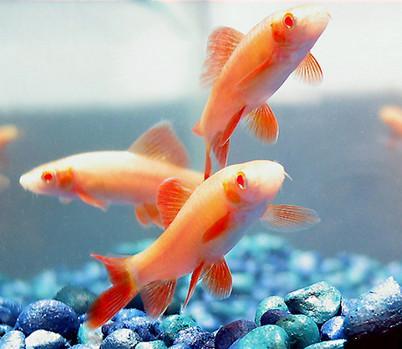
The Golden Shark (or Albino Rainbow Shark) is a peaceful fish that will ignore smaller fish like Tetras when they are small. They go well with semi-aggressive larger fish as they grow older. They are curious fish with lots of personality and character. They will flourish in groups of 6 or more.
Golden Sharks are described as “Sharks” because of their pointed head and a large pointed dorsal fin imitating the body shape of a saltwater shark. In contrast to the salt water shark, these fish are very peaceful in nature. They are active, fast swimmers and will try to jump out of the tank (particularly on its first night in a new environment,) therefore keep the tank covered with a tight glass and perhaps a book or magazines over any small gaps on the first night.
An attractive shark with its gold body and red-orange finnage. They are narrow and elongated with a pointy snout and flat abdominal area. They feature a down-facing mouth, with two set of barbels.
Common Name(s) : Golden Shark, Albino Rainbow Shark
Family : Cyprinidae
Genus: Epalzeorhynchos
Species : Epalzeorhynchos frenatum
Origin : Asia – Indonesia and Thailand.
PH : 6.5 – 7.5
Hardness : Soft to Moderately Hard
Temperature : 24 – 28°C / 75–82°F
Maximum Size : 15cm / 6″
Lifespan : 5-6 years
Aggression Level : Medium-High (7/10) (Territorial especially to other cave dwellers)
Recommended Tank Size : 150 Litres +
Strata : Bottom Half
TANK SET UP
In the wild these fish live over a sandy bottom however it is vitally important in the aquarium that Rainbow Sharks are provided with some cover.
Take note if you also have some other fish that like to escape light (eg Black Ghost Knife) then you will certainly have to provide a covered territory for each. Rainbow Sharks notoriously defend a territory and refuse to share with any squatters.
We find Rainbow Sharks another good choice for a planted tank – take note however the plants must be the hardy, tough type. Plants with “soft” leaves will be consumed by your Rainbow Shark. Suggest Anubias plants, Java Fern, Blue Stricta and Amazon Swords. A heavily planted tank minimizes the territorial behavior this fish is known for.
Also add driftwood, ornaments or rocks to make plenty of hiding places. Certainly make 2-3 different caves at a minimum.
SUITABLE TANK MATES
SUITABLE TANK MATES
Tropical Fish
African Cichlids
Some American Cichlids
DIET
Rainbow Sharks need vegetable matter in their diet to grow properly. They are keen feeders and will grow fast. They enjoy algae wafers, pellets, blood worms, brine shrimp, also will feast on green vegetables like cucumber or zucchini that are skewered on a teaspoon and sunk to the bottom.
SEXING AND BREEDING
SEXING AND BREEDING
Sexing is difficult, however females are plumper. It is unlikely these fish will breed in the aquarium. however there has been some events documented.
A male might curl around a gravid female and fertilize the eggs as they come out. Details are sketchy.
OTHER USEFUL INFORMATION
Rainbow sharks are a mildly aggressive community fish if the aquarium has been set up poorly. Ensure there are plenty of hiding places and plenty of tough plants.
Rainbow Sharks grow to a maximum size of 15cm and are best to be suited to a aquarium of 3 ft plus. They grow quite quickly and are keen eaters. You will often catch them feeding on some algae around the tank or foraging through the substrate looking for food.
Being an omnivore, Rainbow Sharks like a varied diet. They love green vegetables, flake, pellets, algae wafers, brine shrimp and bloodworms.
Soft to medium water is best suited to them with PH levels of 6.8 – 7.4 but they are quite hardy in slightly more alkaline water. Don’t let the water get too acidic.
You will often find them to the rear of the aquarium often hiding behind logs, rocks, caves & plants. They are more active at night time or when the lights are off.
There is also a non albino variety of Rainbow Shark – they are sold as a standard Rainbow Shark featuring a black to grayish body and bright red fins, I find this variety a little more territorial.
All in all if you have the correct setup for these fish then I find they are a good aquisition for a community aqaurium.
